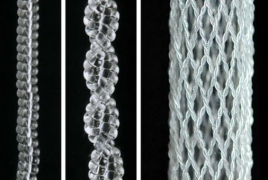MIT researchers build low-cost synthetic muscles out of nylon fiber (video) PanARMENIAN.Net - Researchers have been trying to build durable, low-cost synthetic muscles for years but to no avail. The systems developed so far have either been too expensive to produce en mass (like carbon nanotube) or too delicate and power hungry (looking at you, shape-memory alloys) to be useful outside of laboratory conditions. But a team from MIT have just struck upon the Goldilocks zone of robo-muscles with nylon fiber of all things, Engadget reports. The secret, according to a report published Wednesday, November 3 to the journal Advanced Materials, lies in how the fibers are shaped and heated. See, nylon fibers have this weird natural property that, when you heat them, they contract in length but expand in diameter. That makes them ideal for linear movement, like lifting a weight straight up. But getting nylon to bend as it contracts is not as simple. Typically, getting nylon to bend as it heats requires pulleys to take up the slack, which adds weight, complexity and cost to the system -- the three exact things you want to avoid in creating a mass-produced technology. But the MIT team figured out a clever workaround. Using normal nylon filament, the team first compressed it to change the fiber's cross-section from circular to square. They then heated just one side of the fiber, causing it to contract faster than the unheated side and forcing the entire strand to bend. The heat source can be anything from electrical resistance to chemical reactions -- even lasers. The fibers are surprisingly resilient, lasting for 100,000 cycles and capable of contracting up to 17 times per second. This breakthrough could lend itself to a wide variety of industrial and commercial applications, Engadget says. Like powered clothing that automatically contracts to your precise body shape, which means everything on the rack is in your size. These fibers could also be used in cars and airplanes. With these fibers, a vehicle's exterior could reshape itself on the fly to minimize drag. The technology could even lend itself to self-adjusting catheters for insulin pumps. And eventually, we may even see them in biomimetic robot muscles. Yerevan will host the 2024 edition of the World Congress On Information Technology (WCIT). Rustam Badasyan said due to the lack of such regulation, the state budget is deprived of VAT revenues. Krisp’s smart noise suppression tech silences ambient sounds and isolates your voice for calls. Gurgen Khachatryan claimed that the "illegalities have been taking place in 2020." Partner news |